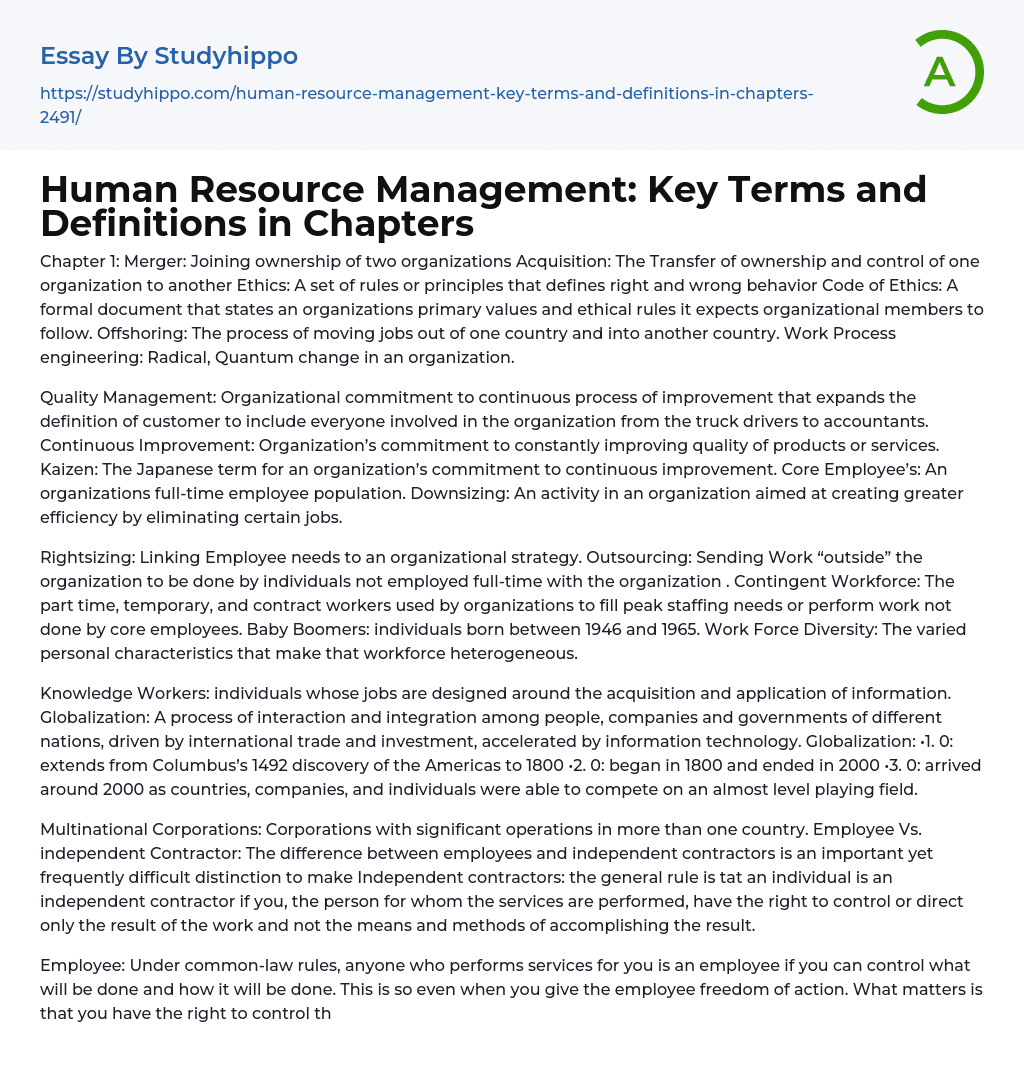

Human Resource Management: Key Terms and Definitions in Chapters Essay Example
Chapter 1: Merger and Acquisition, Ethics, Code of Ethics, Offshoring, and Work Process engineering are all interconnected methods or concepts within the field of organizational management.
Quality management refers to an organization's dedication to continuously improving processes and including all members of the organization in the definition of "customer," from truck drivers to accountants. Continuous improvement is when an organization is committed to constantly enhancing the quality of its products or services. Kaizen, a Japanese term, represents an organization's commitment to continuous improvement. Core employees are the full-time employees of an organization. Downsizing is an activity in an organization that focuses on increasing efficiency by eliminating certain jobs.
Rightsizing, also known as linking employee needs to an organizational strategy, refers to the process of sending work outside the organization to be done by individuals who are not employed full-time with the organization. T
...his is often done to fill peak staffing needs or perform work that is not done by core employees. The contingent workforce includes part-time, temporary, and contract workers. Baby Boomers are individuals born between 1946 and 1965. Work force diversity refers to the varied personal characteristics that make the workforce heterogeneous.
Knowledge Workers are individuals whose jobs involve acquiring and applying information. Globalization is the interaction and integration among people, companies, and governments from different nations, driven by international trade, investment, and accelerated by information technology. This process can be categorized into three phases: 1.0 (1492-1800) with Columbus's discovery of the Americas; 2.0 (1800-2000); and 3.0 (around 2000) enabling countries, companies, and individuals to compete more equally.
Multinational Corporations are corporations that operate in multiple countries. Differentiating between employees and independent contractors can be challenging. The general
rule for independent contractors is that if you, as the recipient of the services, only have control over the outcome of the work and not how it is done.
According to common law, an individual is deemed as an employee if they can be directed in terms of tasks and methods while providing services. This classification remains irrespective of the extent of freedom given to the individual. The crucial aspect lies in possessing the authority to control the specific details concerning how the services are executed. Chapter 2: Frederick Taylor is acknowledged as the forerunner of scientific management.
Edwards Deming, a quality expert, is credited with helping Japanese firms improve their productivity after World War II. Mary Parker Follet, an early management theorist, was a forerunner of today's teamwork concept. Frederick Taylor developed principles to enhance worker productivity. Hugo Munsterberg devised improvements to worker testing, training, evaluations, and efficiency. Mary Parker Follet advocated for people-oriented organizations. Elton Mayo’s Hawthorne Studies revealed that the dynamics of informal work groups have a bigger effect on worker performance than wage incentives.
Management is the process of efficiently completing activities with and through people. Planning is a management function that focuses on setting organizational goals and objectives. Organizing is a management function that deals with determining job assignments, decision-making authority, and employee grouping. Controlling is a management function concerned with monitoring activities to ensure goals are met. Leading is a management function concerned with directing the work of others. Strategic Human Resource Management involves aligning HR policies and decisions with the organizational strategy and mission.
Staffing Function: In HRM there are activities concerned with seeking and hiring qualified employees. Training; Development Functions: There
are activities in HRM concerned with assisting employees to develop up-to-date skills, knowledge, and abilities. Motivation Function: HRM activities are concerned with helping employees exert at high energy levels. Maintenance Function: There are activities in HRM concerned with maintaining employees' commitment and loyalty to the organization. Communications Programs: These are HRM programs designed to provide information to employees. Labor Unions: These act on behalf of their members to secure wages, hours, and other terms and conditions of employment.
Management Thought: Early Theories that promoted today’s HRM operations
Scientific Management: A set of principles designed to improve worker productivity
Hawthorne Studies: A series of studies that provided new understanding of group behavior and motivation.
Compensation and Benefits: HRM function focused on employee payment and benefits administration
Employee Relations Function: HRM activities concerned with effective communication among organizational members.
Outsourcing refers to the process of contracting with a company to handle one or more HR functions. On the other hand, a Professional Employer Organization (PEO) assumes all HR functions of a client company by hiring all of its employees and leasing them back to the company. Shared activities involve sharing HRM activities among geographically dispersed divisions. An HR Generalist is a position that is responsible for all or a large number of HR functions in an organization. The Serbanes-Oxley Act establishes procedures for public companies regarding how they handle and report their finances.
- Qualities essays
- Leadership and Management essays
- Change Management essays
- Project Management essays
- Knowledge Management essays
- Operations Management essays
- Quality Management essays
- Risk Management essays
- Scientific Management essays
- supply chain management essays
- Performance Management essays
- Time Management essays
- Brand Management essays
- Total Quality Management essays
- Risk essays
- Manager essays
- Leadership essays
- Business Ethics essays
- Board Of Directors essays
- Product Management essays
- Comparative Analysis essays
- Decision Making essays
- Dispute Resolution essays
- Stress Management essays
- Business Management essays
- Brand Equity essays
- Branding essays
- Nike, Inc. essays
- Market share essays
- Razor essays
- Being A Leader essays
- Servant Leadership essays
- Leadership Experience essays
- Leadership Qualities essays
- Incentive essays
- American Dream essays
- Barriers To Entry essays
- Capitalism essays
- Central Bank essays
- Compensation essays
- Consumerism essays
- Economic Development essays
- Economic Growth essays
- Economic Inequality essays
- Economic System essays
- Economy essays
- Employment essays
- Export essays
- Finance essays
- Free Trade essays



